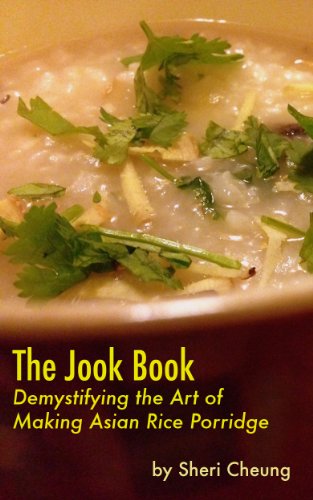What is congee you ask? Also known as Jook, congee is a soupy mixture of rice, water, vegetables and other ingredients to boost longevity, soothe the sick and strengthen the digestive system. In short, it's Asian belly magic.
The first time I ever had congee was while living abroad outside Tokyo in the late 90's. My face swelled up like a gopher after having a wisdom tooth pulled and my Japanese friend’s mother found me curled on the living room tatami in the fetal position. She brought me a bowl of Japanese style congee since it was the only thing I could get past my swollen gums. It was simple, nourishing, and like nothing I had grown up with.
Fast forward a few years to Chinese medicine school where congee is a cornerstone to dietary therapy.
I immediately recognized it, rushed home from class to make it, and out came a brick of congealed rice. I couldn't figure out what I had done wrong. So I experimented off and on over the next decade, but just couldn't get it right. It was my secret shame as a Chinese medicine practitioner - my congee sucked.
Fast forward to now. It’s taken years of practice, combing through "Jook Books", and going to Congee Village in NYC’s lower east side which sets the gold standard. But since I can’t always go out for congee and food is medicine - learning to cook congee that you like is one of the best things you can do for yourself and your family. Once you’re able to nail the basics, you can get incredibly creative and congee is a perfect easy to digest base for anything from sweet, to savory, to salty, to heaven. I can't recommend it enough. There's a reason that Chinese medicine, even after thousands of years, continues to celebrate, enjoy, and write odes to congee.
Why get your congee on?
There's a difference between porridge and congee; one is made from oats, the other from rice. Because rice is considered a "neutral grain" in Chinese medicine, congee makes an amazing base that can metabolically rev you or cool you down depending on what you add to it. There are a bajillion reasons why to eat it, but here are just a few...
Congee fires up the digestive system
The "Earth School" teaches that the primary place to start with any treatment is the gut. If your digestion is kaput, so is everything else. Congee is easy to digest, incredibly nutritious, and acts as a base to add seasonally appropriate foods or herbs.
Congee is the breakfast of champions
Beats Wheaties any day. Because it's so easy to digest, it doesn't force the body to overwork and the system can easily metabolize it. Warm congee in the morning sets the blood sugar for the day so you're not craving the "CSC Triad" of caffeine / sugar / carbs at 3pm. It's low glycemic and one cup of congee equals about 150 calories; lighter than many other breakfast foods yet highly nourishing.
Congee moves the blood
Warm congee makes a warm body. Chinese medicine practitioners sometimes like to say "ice is for dead people". That logic taken to the next step is "warmth is for the living". All the nourishing life traditions and teachings focus on circulating and warming - both of which congee excels at.
Congee convalesces
Because it's so easy to digest and deeply nutritious, it's often used to help aid in recovery from things such as postpartum, flu, chemotherapy, post surgery, and is given to anyone having trouble eating solid food (i.e. anyone who's had a wisdom tooth pulled).
Congee keeps you Hydrated
Congee contains up to 90% water. No matter the biome - dry or humid, cold or hot - we can all use a bit more hydration. The starchy mix in the congee can stay in the body longer than other types of food and allow the system to digest at a slower pace.
The secret to good congee is in the proportions
For a smoother congee, go with a 10:1 ratio of liquid to rice
For a thicker gruel like congee, go with a ratio of 7:1
Get Cookin'
Throw everything into a pot
Bring to a boil; immediately drop to a simmer for an hour.
When cooked pull the mean off the bones.
Stir in the egg during the last minute of cooking right before it's served
Voilà
Ingredients
5 cups water
5 cups bone broth (you can also just use water, either works - in which case it would be 10 cups water)
1 cup sushi or jasmine rice
2 chicken drum sticks
1 package of baby bella mushrooms
2 eggs
Get Frisky
Some easy additions that you can stir into the pot or throw into single servings...
Mix in a tiny bit of apple cider vinegar or balsamic, a scoop of miso, and sprinkle with scallions.
Add a poached egg, top with scallions / parsley / cilantro, add a few pieces of lotus root, and a dash of paprika.
Sprinkle in some black sesame seeds, tear up a couple shiso leaves, toss in a few umiboshi and 1/2 teaspoon of tamari.
For the last half hour, mix in a few few cubes of butternut squash, couple sticks of cinnamon, a dash of maple syrup, and teaspoon of ghee.






